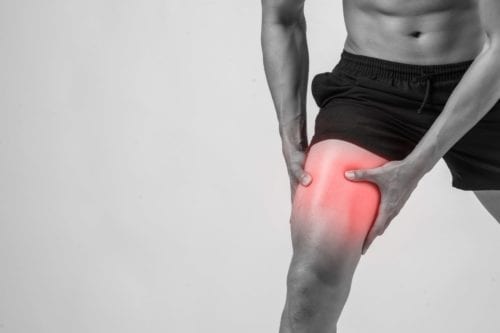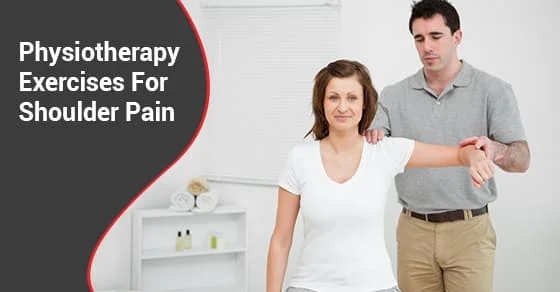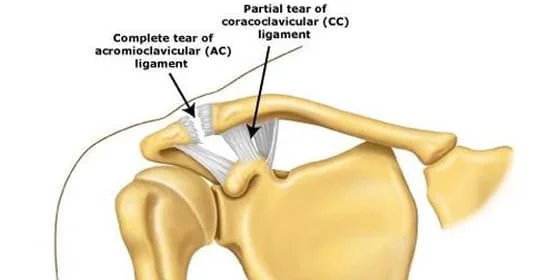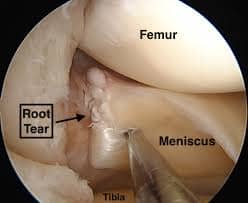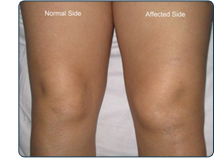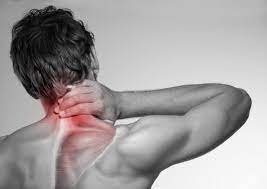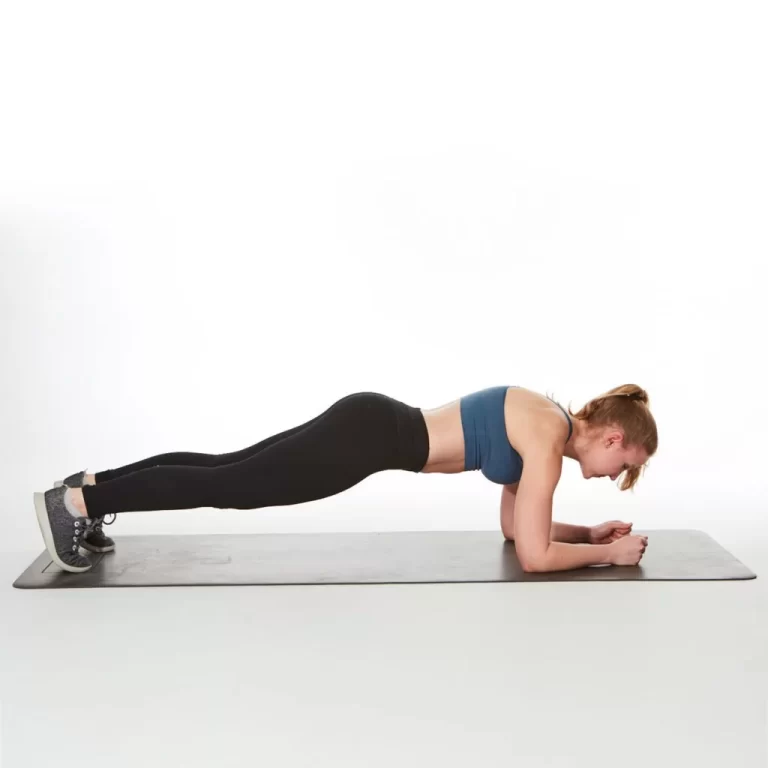Thigh muscle strain
Table of Contents
What is a thigh muscle strain?
A Thigh muscle strains (muscle pull or tear) usually happen when a thigh muscle is stretched beyond its limit, and therefore the muscle tissue becomes torn during an activity such as sprinting or kicking a ball. they often occur near the point where the muscle joins the tough, fibrous connective tissue of the tendon. an identical injury occurs if there is a direct blow to the muscle. Muscle strains within the thigh can be quite painful.
The thigh has three sets of strong muscles: the hamstring muscles within the back of the thigh, the quadriceps muscles within the front, and therefore the adductor muscles on the inside. The quadriceps located at the anterior accept of the thigh is responsible for extending the knee and bending the leg. The quadriceps group is formed up of four muscles: Rectus Femoris, Vastus Medialis, Vastus Lateralis, and Vastus Intermedius. The adductor muscles drug the legs together.
The hamstring and quadriceps muscle groups are particularly in danger of muscle strains because they cross both the hip and knee joints. they’re also used for high-speed activities, like track and field events (running, hurdles, long jump), football, basketball, and soccer.
Where is thigh muscle located?
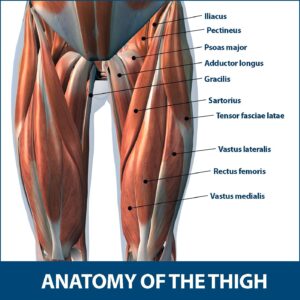
The thighs contain a number of the largest muscles in the body. The thigh muscles allow the lower body to flex, bend and rotate. They also bear most of the body’s weight and keep the hips and legs aligned, additionally providing and assisting with balance.
Thigh muscles are often grouped based on their function and location:
- Adductors muscles
- Hamstrings muscles.
- Pectineus.
- Quadriceps.
- Sartorius.
Adductors include five muscles: obturator externus, gracilis, adductor longus, adductor brevis, and adductor Magnus. they’re on the within of the thigh, starting at the pelvis and increasing to the femur (thigh bone).
Hamstrings are a bunch of three muscles: semitendinosus, semimembranosus, and biceps femoris. They run down the posterior of the thigh, from the hip just below the knee.
The pectineus could even be a flat muscle that extends from the front of the pelvis to the top of the femur.
Quadricep muscles include four large muscles located within the anterior of the thigh: vastus lateralis, vastus medialis, vastus intermedius, and rectus femoris. they begin at the pelvis (hip bone) and femur (thigh bone) and extend down to the tibia (shin bone)and patella (kneecap).
Sartorius’s muscle is a long, thin muscle — the longest within the human body. It starts by the hip and wraps across the anterior of the thigh, then downward toward the knee
What is the cause of thigh muscle strain?
An acute thigh muscle strain is one time your muscle tears quickly and unexpectedly. Muscle tears will be due either to injuries or trauma. this will respond to
- Not warming up properly before physical exercise
- Poor flexibility
- Poor exercise
- Overexertion and fatigue
- Weakness
Acute injuries are generally the result of a single traumatic event and affect a macro-trauma to the muscle. There’s an articulate link between the cause and noticeable symptoms. they’re also used for high-speed activities, like track and field events (running, hurdles, long jump), football, basketball, and soccer.
Overuse ( chronic or exercise-induced injuries) is subtler and generally done over a longer period. They result from repetitious micro-trauma to the muscle. Diagnosing is more challenging since there’s a less noticeable link between the cause of the injury and the symptoms.
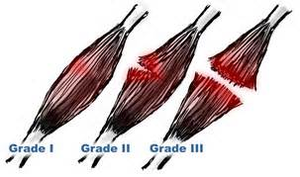
Thigh muscle strain classification
A tear during a thigh muscle is referred to as a thigh strain and depending on its severity it is classified as a first, second, or interrogation strain:
- First degree: The mild strain is damage to some muscle fibers
- Second degree: The moderate strain is damage to a more extensive number of muscle fibers
- Third degree: Most severe strain may be a complete rupture of the muscle itself
Sing and Symptoms of thigh muscle strain
There are some usual symptoms of a muscle strain including:
- Popping or snapping sensation because the muscle strain.
- Sudden and severe pain.
- The injured area could also be tender to the touch, with visible bruising if blood vessels also are broken.
- Grade 1
- With a grade one thigh strain the signs might not be present until after the activity is over. There could also be a sensation of cramp or Thigh tightness and a slight feeling of pain when the muscles are stretched or contracted.
- Grade 2
- With a grade two thigh strain there’s immediate pain which is more severe than the pain of a grade one injury and produces pain on walking. it’s confirmed by pain during stretch and contraction of the muscle. A grade two Thigh strain is typically sore to touch.
- Grade 3
- A grade three thigh strain may be a complete rupture of a muscle and is a serious injury. there’s immediate burning or stabbing pain and the athlete is unable to walk without pain. Often there’s a depression in the thigh at the location of the tear and a lump above the depression. After some days with grade two and three injuries, a large bruise will appear below the injury site caused by bleeding within the tissues.
Thigh muscle strain complications
Complications that can occur include:
- Decreased range of motion
- Reduced muscle strength
- Pain and infection — if surgery is required to repair a strain
Risk Factors
- Several factors can put at risk of you muscle strains, including:
- Muscle tightness. Tight muscles are vulnerable to strain. Athletes should go after a year-round program of daily stretching exercises.
- Muscle imbalance. Because the hamstring and quadriceps muscles work together, if one is stronger than the other, the weaker muscle can become strained.
- Poor conditioning. If your muscles are weak, they’re less ready to cope with the stress of exercise and are more likely to be injured.
- Muscle fatigue. Fatigue reduces the energy-absorbing abilities of muscles, making them more susceptible to injury.
Thigh muscle strain diagnosis
- Your doctor can diagnose a thigh muscle strain during a physical examination.
- Medical history: to decide when symptoms began and potential activities that force have caused the sprain or strain.
- The doctor will also look for swelling on the thigh area that indicates a quads tear, hamstring tear, or strain. to confirm your diagnosis, your doctor can also order an X-ray or MRI.
- X-rays will provide a two-dimensional image of the overall structure of your thigh hip, knee, and pelvic. They help identify instability, avulsion fractures, abnormal bone shapes, or other problems.
- CT scans and diagnostic ultrasounds may be used to look internally at muscles and tendons.
- MRIs will provide more information and will help to evaluate the soft tissues in and around your hip joint. They can identify tendon or ligament damage and can help to determine the extent of your injury, the grade of your tear or inflammation, as well as other similar conditions.
Assessment
Subjective assessment
- History with associated symptoms
- Mechanism of injury
- Inciting trauma-direction and extent of injury force
- Repetitious trauma- defective postural-related injuries
Observation
- Strain injuries of the thigh may present with an obvious deformity similar to a bulge or defect in the muscle belly.
Palpation
- Tenderness
- Swelling
Treatment
Medical Treatment
Thigh muscle strains infrequently require surgery and still may be necessary for a complete rupture.
For immediate
- Nonsurgical, Conservative treatment maximum muscle strains do not demand surgery if the muscle is fully damaged doctors suggest surgery If there is a partial gash also the athlete can replace when they are effortless and have normal strength and movement. this generally occurs following anywhere from many weeks to many months of significant treatment and therapy. When the muscle is fully damaged, the athlete may advantage from surgical repair. e tone- care of a muscle strain.
- Some therapists suggest avoiding inimical pain medicines that can extend your threat of bleeding — similar to over-the-counter (OTC) medicine (naproxen sodium (Aleve) aspirin and ibuprofen (Advil, Motrin IB), — during the first 48 hours after a muscle strain. Acetaminophen (Tylenol) and others can be helpful for pain relief during this period.
- A physiotherapist can help you to increase the strength and stability of the injured joint or limb. Your doctor may suggest that you stabilize with a brace. For some muscle injuries, thigh muscle sprint surgery may be called.
To prevent swelling and pain as first aid by following RICE principal
- R- rest
- I- ice for cooling
- C- compression tapping and splinting
- E- elevation
the R.I.C.E approach
Most muscle strains are often treated with the RICE protocol.
- This made it help to limit swelling and bleeding in the tissues. After the first days have been taking resting more active rehabilitation can be started.
- Rest will relieve the pressure from the joint and subside the pain slightly. Avoid activities that aggravate the matter.
- Applying Ice to the affected area can help decrease inflammation and pain. Try applying ice for 10-15 minutes 2 to 3 times each day.
- Compression prevents additional swelling, so lightly wrap the injured area with a soft bandage or ace wrap.
- Elevation reduces swelling. Raise your leg above your heart.
Physiotherapy treatment
The aim of activity treatment is
- Relieve thigh muscle pain
- Reduce muscle swelling
- Increases thigh muscle strengths.
- Improve full mobility of the ligament and corresponding joint
- Restore patient’s confidence
- Restore the patient’s whole functional activity
Acute stage
Physiotherapy rehabilitation can be started after 48 hours of injury, For the first few days give an electric modality give to relieve swelling and pain.
Electrotherapy
- Ultrasound
- Ultrasound has been used for tissue healing
- Increases blood circulation and mobility.
- To reduce swelling and pain
- Cryotherapy
- Inflammation and swelling can be reduced by applying cryotherapy in form of ice packs, and cold water baths to the affected area.
- Continuous application of colds several times a day for 15-30 minutes at a time is recommended.
- TENS
- Trans-cutaneous electrical nerve stimulation (TENS) may be able to help reduce pain and muscle spasms.
- Interferential therapy (IFT)
- There are the main clinical applications for which IFT appears to be used:
- Pain relief
- Muscle stimulation
- Increased local blood flow
- Reduction of edema
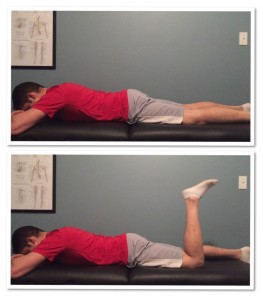
Strengthening exercise
After pain relief start strengthening exercise
1)Active range of motion exercises
- This exercise is beneficial in the early stages of rehabilitation whilst motion is particularly limited.
- Simply flax and straighten the knee through its full pain-free range of motion.
- this will be done in the sitting position, the standing position, and lying down.
- don’t overstretch too soon. If it’s painful then avoid it!
- Perform 10 reps at a time, a minimum of 3 times a day.

2)Isometric quadriceps contractions
- Static contractions are often used very early on in the rehab process. They involve contracting the muscle with no movement of the leg. this will be done in standing or sitting with the legs out straight.
- Hold for 10 seconds at a time.
- Relax for five seconds before repeating and perform 10 repetitions. As your strength improves, increase sets to 3 or 5 sets of 20 reps.
- Although this exercise is boring it’ll maintain muscle bulk and ensure you are back to full fitness faster.
- Continue with this exercise day to day until you can perform the concentric exercises below.
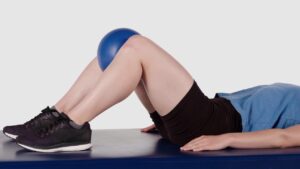
3)Adductor Squeeze (Crook Lying)
- Begin this groin strengthening exercise lying on your back within the position of knee bending with a rolled towel or ball in the middle of your both knees.
- Slowly squeeze the ball in the middle of your both knees tightening your inner thigh muscles (adductors).
- Hold for 5 seconds
- Do10 to 15 repetition

4)Straight leg raise
- This is a more advanced exercise. Sit upright with feet rotated outwards. Lift one leg slightly off the bottom, move the leg outwards whilst avoiding the ground
- Return to the center, then either rest for a pair of seconds, or if strong enough take the leg out again without resting.
- This exercise progressed additionally performing it on a bed with one leg relaxed down the side of the couch.
- Raise the leg upwards and across the opposite leg, lower, and repeat 8 to 10 times.

5)One leg standing
- Stand with your feet hip-width apart and your weight equally distributed on your legs.
- Place your hands on your hips. Lift your right leg up from the ground and bend it back at the knee.
- Hold the position as long as you can maintain good form, up to 15 seconds.
- back to the starting position.
- repeat on the left side.
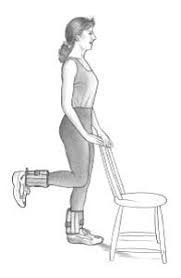
6) Standing knee flexion
- Stand on the right leg and bend the left leg using just gravity as resistance.
- Start gently and slowly to start with as an early stage exercise.
- Aim for 3 sets of 10 to 15 repetitions once a day, building to 4 sets of 15 to 20 reps.
- Ankle weights are often used to increase the load further.
7)Resistance Band Hip Adduction

- Stand straight with both feet placed jointly. tie a resistance band on your ankles.
- Hold a gentle object with your hands for support. you’ll also do this without any support, counting on your fitness level.
- Keeping your left leg firmly on the ground, raise the proper leg on your side, stretching the maximum amount as you can.
- Take an interruption and bring your leg back to its initial position, releasing the strain of the resistance band.
- remain your right leg firm, raise your left leg to your sides, stretch the band, and return to the starting position.
- Repeat this exercise several times to strengthen the groin muscles and therefore the knees. It also prevents the falling of the knees during running and squatting.
- Do 2 sets of 8 reps.
Chronic stage: after 4 week

Stretching and strengthening exercise
1)Static quadriceps stretch
- This can be performed in either laying or standing on your front.
- Pull the foot of the injured leg towards your buttock until you’ll feel a gentle stretch on the front of the thigh.
- To extend the stretch, tilt your hips backward.
- Hold for 15-30 seconds
- Repeat 3 times per set

2)Lunges
- Bend the knees and lower your body until the rear knee is a few inches from the floor.
- At the underside of the motion, the front thigh is parallel to the bottom, the rear knee points toward the floor, and your weight is evenly distributed between both legs.
- Keep off up to the starting position, keeping your weight on the heel of the front foot.

3)Wall squats
- From your starting position, slow your body downward, and hold for time. As you perfect, extend the volume of time you hold the wall squat.
- Be sure to observe your pelvis, back, and head against the wall.
- Keep the movement pain-free. (A variation to increase activation of the VMO would be to squeeze a ball in the middle of your knees as you perform the exercise. Typically the ball would be about 12 inches in diameter)
- Perform 3 sets of 15-20 seconds holds one time per day.

5)Plie Squat
- Stand together with your hands placed on the front of your thighs, near your groin.
- Place your feet wide apart so that your toes are pointing outward on one side and the other.
- Bend your knees and lean on your hips out. Keep your weight on your heels and lift your hands straight in front of you. Your palms should be facing down.
- Hold for a flash and come back to your initial position by pushing your heels to straighten your legs.
- you’ll also do this exercise with weights in your hands to increase the intensity. Do 1 set of 8 reps.

6) Step up
- Step up with the left foot, pressing the heel to straighten your left leg.
- Bring the right foot to touch your left foot on top of the step.
- Bend your left knee and step back down with the right foot.
- Bring the left foot down to the touch right foot on the floor.
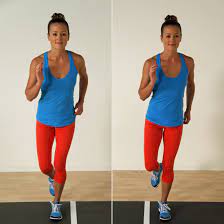
7)Lateral hops
- Keeping your legs together, jump from side to side, jump over an imaginary obstacle, Land with soft knees, and Try to remain on the balls of your feet

8)Squat jump
- Stand with your feet shoulder-width apart.
- Start by going a regular squat, engage your core, and jump up explosively.
- When you land, lower your body back into the thickset position to complete one rep.
- Make sure you back down with your entire bottom on the ground.
- Do two to three times of 10reps per day.
Precautions
- You can use the following precautions to help prevent muscle strain:
- Condition your muscles with a daily program of exercises. you’ll ask your physician about exercise programs for people of your age and activity level.
- Warm up previous any exercise session or sports activity, including practice. an honest warm-up prepares your body for more intense activity. It increases your breathing rate, gets your blood flowing, and raises your muscle temperature. Warming up gives your body time to regulate the demands of exercise and can help increase range of motion and reduces stiffness.
- Take time to chill down after exercise. Stretch slowly and gradually, holding each stretch to offer the muscle time to respond and lengthen. you’ll find examples of stretching exercises on this website or ask your physician or coach for help in developing a routine.
- If you’re injured, take the time needed to let the muscle heal before you come back to sports. Wait until your muscle strength and adaptability return to preinjury levels. this will take 10 days to 3 weeks for a mild strain, and up to six months for a severe strain, like a hamstring strain.
FAQs
How do you immediately treat a strained thigh muscle?
Rice approach
Rest.
Ice.
Compression.
Elevation.What does a thigh strain feel like?
The main symptom of a thigh strain is a pain in the thigh that feels like a popping or snapping sensation. further signs and symptoms may involve: Pain during walking or using the affected muscle. Bruising, swelling, or tenderness within the affected thigh.
What is the difference between muscle strain and tear?
Sometimes the injury is more cut off, and one, a few, or all of the muscle fibers get torn. during this case, you’ve got a muscle tear. A muscle strain is an injury that happens when a tendon or a muscle is overstretched.
Should I stretch a strained muscle?
While it’s going to appear illogical, stretching a strained muscle only makes it worse. Your best bet involves avoiding any movement that presses the affected area and still resting until the pain subsides. Light stretching can assist with a minor strain, but as long as incorporated a few days after the injury occurred.
what are the symptoms of thigh muscle?
Popping or snapping sensation because the muscle strain.
Sudden and severe pain.
The injured area could also be tender to the touch, with visible bruising if blood vessels also are broken.

